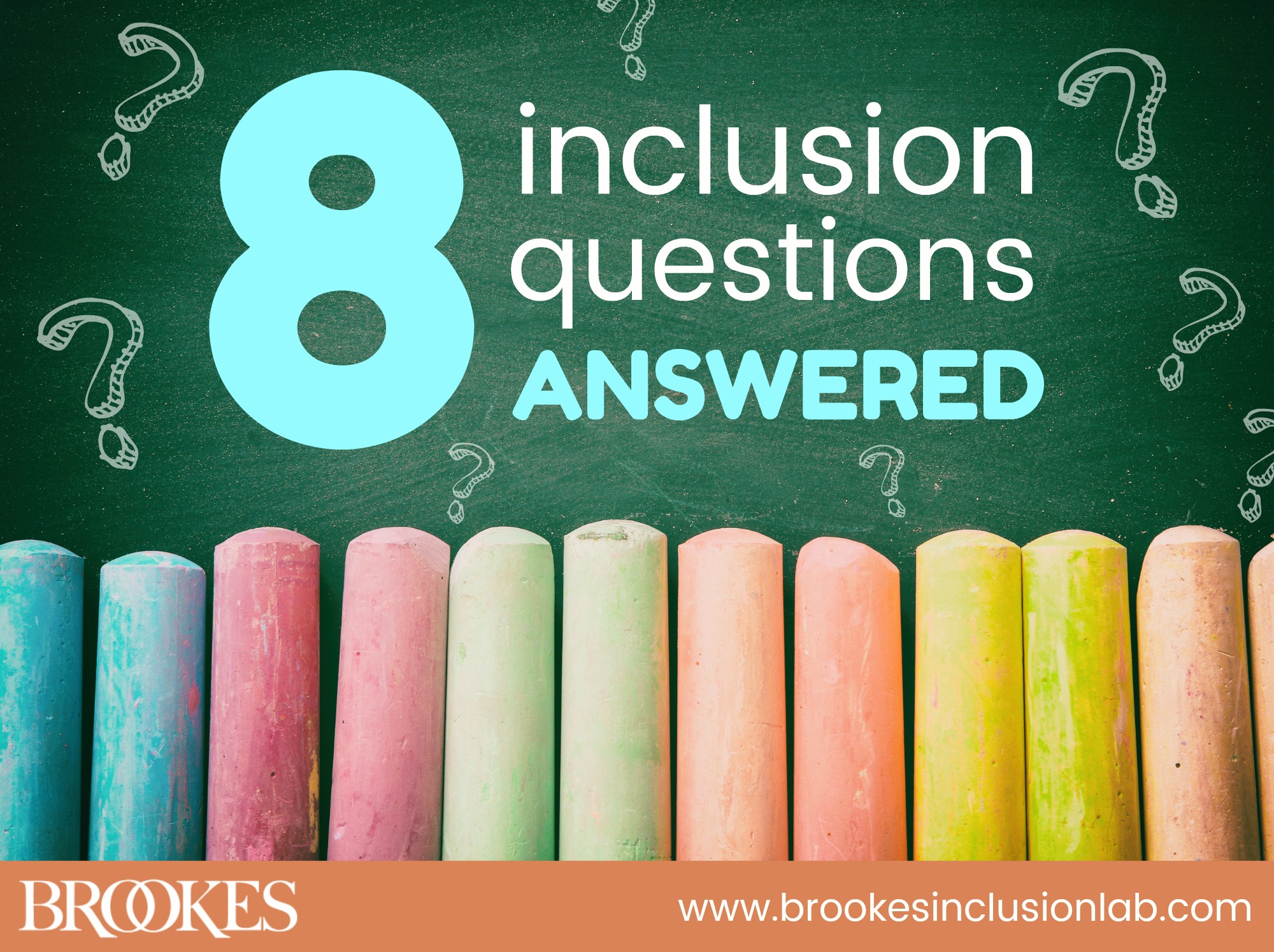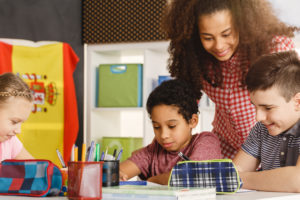8 Need-to-Know Inclusion Questions, Answered by Our Experts!
December 3, 2019
Happy Inclusive Schools Week, teachers, and thanks for everything you do to all year long to make every learner feel safe, respected, and welcomed. Our hats are off to you, this week and EVERY week.
On this blog, it’s a tradition to celebrate Inclusive Schools Week with some practical inclusion tips from the experts. This year we’ve put together an 8-question Q&A for you, excerpted and adapted from some popular inclusion guides. Here, leading inclusion experts like Paula Kluth, Cheryl Jorgensen, and Julie Causton answer some of the most frequently asked questions about inclusive education. Read on to see if they’ve answered your biggest inclusion question (and if you don’t see yours on the list, add it in the comments below)!
Can my school choose whether or not to offer inclusion?
Answered by: Paula Kluth, in the book You’re Going to Love this Kid!:
 I often hear teachers and families talking about inclusion as if it is something schools can choose to adopt (or reject). For instance, I met a teacher who told me that her school had been inclusive but they felt it was not working well and, therefore, decided to move back to a more restrictive model. Similarly, a parent sent me a letter explaining that she wanted her child to have an inclusive education but her neighborhood school “doesn’t have it.”
I often hear teachers and families talking about inclusion as if it is something schools can choose to adopt (or reject). For instance, I met a teacher who told me that her school had been inclusive but they felt it was not working well and, therefore, decided to move back to a more restrictive model. Similarly, a parent sent me a letter explaining that she wanted her child to have an inclusive education but her neighborhood school “doesn’t have it.”
In both of these situations, the law is not clearly understood. If a student with disabilities can be successfully educated in a general education setting (with the appropriate supports and services), then the student’s school must provide that experience. Schools cannot claim that they do or do not “offer” or “do” inclusion. Special education is not a program or a place and inclusive schooling is not a way of doing business that schools can dismiss outright. As the law indicates, students with disabilities should only be removed from general education “when the nature or severity of the disability is such that education in regular classes with the use of supplementary aids and services cannot be achieved satisfactorily” (IDEA, PL 101-476, § 612[a][5]). Therefore, in cases in which students can be educated in general education “satisfactorily,” the school must “offer” inclusion.
I’m concerned about the effect that students with more significant disabilities will have on my other students. Do they draw resources and attention away from the rest of the class?
Answered by: Cheryl Jorgensen, in the book It’s More Than “Just Being In”:
 This is a common question, and I can answer it in three ways. First, let me reassure you that the research—and there is more than 40 years of it—shows that the learning of students without disabilities is not adversely affected by having students with disabilities as part of a heterogeneous general education classroom. It is important to focus on the word heterogeneous. A truly inclusive classroom is one in which there is a natural proportion of students with and without disabilities. There should be about three or four students with disabilities in a class of 25 students and certainly no more than one student with IDD or other complex support needs such as ASD. If the ratios are heavily weighted toward children with disabilities, then that is not really an inclusive classroom, and I have seen the negative academic and behavioral consequences of that arrangement. Furthermore, the research shows that students without disabilities have more positive attitudes toward people with disabilities when they grow up with and go to school with students who have disabilities.
This is a common question, and I can answer it in three ways. First, let me reassure you that the research—and there is more than 40 years of it—shows that the learning of students without disabilities is not adversely affected by having students with disabilities as part of a heterogeneous general education classroom. It is important to focus on the word heterogeneous. A truly inclusive classroom is one in which there is a natural proportion of students with and without disabilities. There should be about three or four students with disabilities in a class of 25 students and certainly no more than one student with IDD or other complex support needs such as ASD. If the ratios are heavily weighted toward children with disabilities, then that is not really an inclusive classroom, and I have seen the negative academic and behavioral consequences of that arrangement. Furthermore, the research shows that students without disabilities have more positive attitudes toward people with disabilities when they grow up with and go to school with students who have disabilities.
Second, numerous research studies show that the academic achievement of all students rise when schools or districts embrace inclusive education as a schoolwide effort—with strong leadership from the principal, a lot of professional development for teachers, and the availability of common planning time for teams.
Third, your question about students with disabilities taking attention and resources away from the other students really makes me wonder if you and the whole class are getting the support that you need. Students with disabilities educated in general education classes are entitled to supplementary aids and services to enable them to learn, and those aids and services also include resources for the classroom teacher, such as training, special education personnel who come into the classroom to share the teaching load, AT, behavioral support, and common planning time. I also recommend that the IEP teams of students with complex support needs have 1 hour of common planning time per week.
I hope that you will sit down with the other members of your students’ IEP teams and your administrators and have an honest discussion about what supports you need to teach all the students in your classroom well. You deserve no less and neither do they.
How do I meet the number of minutes for special education services on the IEPs unless I pull students out?
Answered by: Julie Causton & Chelsea Tracy-Bronson, in The Educator’s Handbook for Inclusive School Practices:
 Services can be carried out in many ways. The law suggests that services are portable and should be brought to the student. Therefore, your time could be spent pushing into the general education classroom, running a center, or even recommending ideas to the other educators about how to carry out specific skills while they teach. Your time could be spent modifying or adapting the material so the student can be successful in the general education classroom and throughout the school day. Planning or specially designing the instruction or the materials so that goals can be met seamlessly throughout the day is more effective than pulling a student out.
Services can be carried out in many ways. The law suggests that services are portable and should be brought to the student. Therefore, your time could be spent pushing into the general education classroom, running a center, or even recommending ideas to the other educators about how to carry out specific skills while they teach. Your time could be spent modifying or adapting the material so the student can be successful in the general education classroom and throughout the school day. Planning or specially designing the instruction or the materials so that goals can be met seamlessly throughout the day is more effective than pulling a student out.
I understand the benefits of inclusion for students with disabilities, but how do typically developing children benefit from inclusion?
Answered by: Sarika Gupta, in the book First Steps to Preschool Inclusion:
Typically developing children benefit from inclusion through:
- More positive attitudes toward diverse peers
- Increased social skills (e.g., initiating interactions, negotiating, sharing)
- Demonstrating fairness and equity in play
- Modeling both prosocial and academic behaviors to peers with disabilities
- Becoming natural, confident leaders who are less likely to view disability as an impairment
- Increased likelihood that they will initiate friendships and assist individuals with diverse needs and qualities
I do a lot of large-group lectures, worksheets, and paper-and-pencil tests. Am I wrong in thinking that a student with disabilities wouldn’t get a lot out of being in a class like mine?
Answered by: Michael Giangreco, in the book Quick-Guides to Inclusion:
 My first reaction is, “You’re right, it doesn’t sound like that situation matches the needs of the student with disabilities.” This leaves me wondering how many students who don’t have disability labels would find this kind of educational situation a mismatch. Given the diversity of learning styles among students, educators are increasingly questioning whether class lessons that are too frequently large-group, passive, and didactic really meet the needs of very many students.
My first reaction is, “You’re right, it doesn’t sound like that situation matches the needs of the student with disabilities.” This leaves me wondering how many students who don’t have disability labels would find this kind of educational situation a mismatch. Given the diversity of learning styles among students, educators are increasingly questioning whether class lessons that are too frequently large-group, passive, and didactic really meet the needs of very many students.
Activity-based learning is well suited to including learners with a wide range of educational needs and learning styles. One of the gifts that students with disabilities can bring to the classroom is to highlight the need to use more active, participatory, creative approaches to learning. In the process of increasing the amount of activity and participation to accommodate the needs of a student with disabilities, teachers often realize that these approaches are motivating, preferred, and effective for many other students in the class who don’t have disability labels.
Although active and participatory approaches typically require a bit more preparation time, they are more enjoyable for students and teachers alike. I’ve spoken to several teachers who have told me that their teaching has been invigorated because of what they have learned from having a student with a disability in their class. Increasing activity and participation can include a wide range of options, such as individual or cooperative projects, drama, experiments, field study, art media, computers, research, educational games, multimedia, various forms of choral responding, and many others.
Making sure students have a lot of interesting and motivating work to do can have side benefits, such as decreasing behavior problems and encouraging positive social behaviors. Your students can be very creative and helpful in designing active learning experiences, so don’t hesitate to include them in the planning process.
I’m worried about the possibility of students with disabilities being ostracized or left out by their peers. What can I do to encourage friendships and social connections in an inclusive classroom?
Answered by: Carol Tashie and Zach Rossetti, in the book Quick-Guides to Inclusion:
 From talking to students and listening to their stories, we have learned that friendship can be a reality for all students. As a classroom teacher, you have the opportunity to create environments and conditions that foster relationships between all students. Classroom lists and activities should include all students. You can begin the school year having all students participate in “get acquainted” activities. These activities give students the opportunities to get to know their classmates in fun and memorable ways.
From talking to students and listening to their stories, we have learned that friendship can be a reality for all students. As a classroom teacher, you have the opportunity to create environments and conditions that foster relationships between all students. Classroom lists and activities should include all students. You can begin the school year having all students participate in “get acquainted” activities. These activities give students the opportunities to get to know their classmates in fun and memorable ways.
You can utilize cooperative learning lessons in which all students participate, affirming the notions of interdependence and the power of students working together. Learning centers and other small group situations develop social bonds as students teach and learn from one another.
Develop a sense of your students’ individual strengths so you can structure learning situations in which all students both give and receive help. This helps to avoid students without disabilities taking on caregiving roles with their classmates with disabilities, which can become a barrier to the development of friendships. Even when students are working independently, teachers can encourage student connections by allowing them to ask each other for help, proofread first drafts, and brainstorm ideas with each other. These kinds of classroom strategies can provide the foundation for the development of meaningful and reciprocal friendships.
What concrete actions can administrators take to improve their inclusive schooling model?
Answered by: Paula Kluth, in the book You’re Going to Love this Kid!:
If you’re a school administrator, you can:
- Integrate the elements of inclusive schooling into your school improvement plan.
- Attend local, regional, and national conferences related to inclusive schooling (e.g., TASH, PEAK, PEAL, Inclusion Works!).
- Present at local, regional, and national conferences related to inclusive schooling.
- Visit other inclusive schools, and invite faculty members from other inclusive schools to visit your school.
- Organize a teachers’ book club with selections related to inclusive schooling.
- Write about inclusion for blogs, newsletters, magazines, newspapers, or other publications.
- Develop a web site about inclusion.
- Ask students how to make the school more inclusive.
- Ask the parent–teacher organization to address issues related to barriers, school culture, and collaboration.
- Write a grant to launch an inclusion-related project or reform.
I’m a new teacher in an inclusive classroom, and I’m feeling overwhelmed. What are the first things I should focus on to get on the right track?
Answered by: Nicole Eredics, in the book Inclusion in Action:
When I began teaching, I was able to support students by keeping the following ideas in mind:
- It is the classroom teacher’s responsibility to teach ALL students. I can’t stress enough how important it is for inclusive teachers to take responsibility for teaching all students in the classroom. There will be students who require extra learning support and/or special education services beyond the capacity of the classroom teacher, but those extra services do not and should never make up the student’s entire education program.
- Think about what the student can do. Remember that in a strength-based classroom, teachers see the child’s strengths first.
- Focus on ability level and not grade level. This was how I ensured that each student could learn and work on material that was appropriate to his or her learning needs. Having so many different grades in the class made it easy to accommodate different levels of learning.
- Connect and collaborate with staff. Many of my best teaching ideas over the years have come from my colleagues. There is tremendous value in learning from the experience of others. One of my most memorable tips was a positive behavior management strategy that came from my friend’s sister who was also a teacher. Essentially, I grouped the students and gave each group a color. I used the color names to organize student work, activities, lessons, and movement in the classroom. For example, when I wanted the students to line up at the door, rather than have the whole class move toward the door at once, I would ask groups to line up by color.
- Get creative. Think beyond modifying the paper-and-pencil work that is expected of students. Think of ways to appropriately incorporate technology, art, and/or tactile materials into the lesson.
Have a question to add? Head down to the comments section and add it there—we’ll ask our experts to answer any new questions in the new year!




Write a Comment
Your email address will not be published. Required fields are marked *
Post a Comment